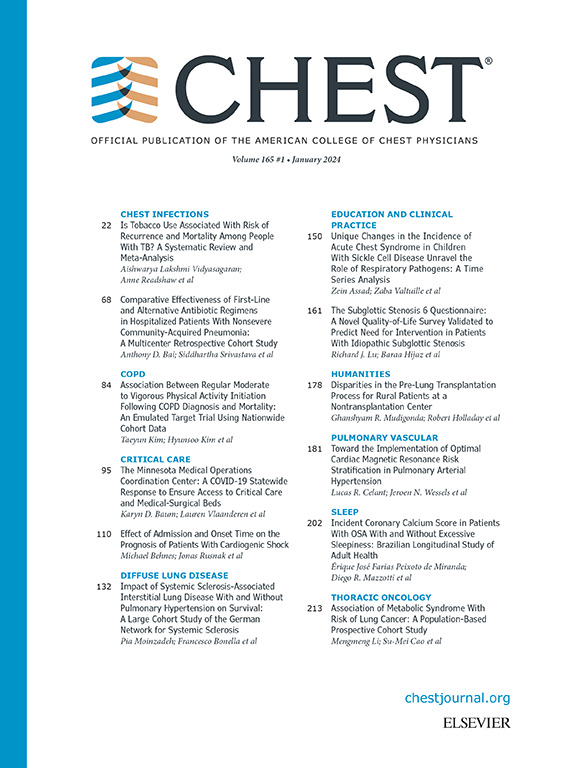Characteristics, Prognosis and ESC/ERS Risk Stratification in Obese Patients with Pulmonary Arterial Hypertension (PAH).
IF 9.5
1区 医学
Q1 CRITICAL CARE MEDICINE
引用次数: 0
Abstract
BACKGROUND The impact of obesity on pulmonary arterial hypertension (PAH) remains largely underexplored, with excess weight potentially masking symptoms and affecting the reliability of current risk stratification tools. RESEARCH QUESTION What are the clinical characteristics and prognosis of obese patients with PAH, and how well do current risk stratification tools perform in this population? STUDY DESIGN AND METHODS We retrospectively included patients with incident PAH diagnosis enrolled at ten European tertiary care centers for PAH management and compared patients with and without obesity, defined by a BMI ≥30 kg/m2. Uni- and multivariable Cox regression models were fitted to assess the association between obesity and 5-years all-cause mortality. Accuracy of the ESC/ERS risk stratification tool for the prediction of annual mortality at baseline and follow up in patients with and without obesity was assessed by ROC curve analysis. RESULTS Among 581 patients included (median age 58 years, IQR 41-75; 61% females), 139 (24%) were obese. Obese patients had more comorbidities and worse symptoms/functional capacity. 5-years crude and adjusted all-cause mortality risk was similar in obese and non-obese. Both the three- (AUC 0.71, 95% CI 0.62-0.81 vs 0.64, 95%CI 0.48-0.80) and the four-strata (AUC 0.79 95% CI 0.69-0.89 vs 0.64 95% CI 0.40-0.88) ESC/ERS risk stratification tool demonstrated lower accuracy for prediction of annual mortality in obese vs non-obese patients, although not statistically significant. However, most components of the risk stratification tool lack a significant prognostic association in obese patients. INTERPRETATION Despite the higher burden of comorbidity and the worse functional class, prognosis is similar in obese compared with non-obese patients with PAH. Currently recommended risk stratification strategies might not be sufficient in patients with obesity claiming for focused research to improve risk stratification across subgroups of patients with PAH.肥胖肺动脉高压(PAH)患者的特点、预后和ESC/ERS风险分层
背景肥胖对肺动脉高压(PAH)的影响在很大程度上仍未得到充分探索,过重的体重可能会掩盖症状并影响当前风险分层工具的可靠性。研究问题肥胖 PAH 患者的临床特征和预后如何,当前的风险分层工具在这一人群中的表现如何?研究设计与方法我们回顾性纳入了在欧洲十家三级医疗中心接受 PAH 管理的 PAH 诊断患者,并比较了肥胖患者和非肥胖患者,肥胖患者的定义是体重指数(BMI)≥30 kg/m2。我们采用单变量和多变量 Cox 回归模型来评估肥胖与 5 年全因死亡率之间的关系。ROC曲线分析评估了ESC/ERS风险分层工具预测肥胖和非肥胖患者在基线和随访期间年死亡率的准确性。肥胖患者合并症较多,症状/功能能力较差。肥胖者和非肥胖者的5年粗死亡率和调整后全因死亡率风险相似。三层(AUC 0.71,95% CI 0.62-0.81 vs 0.64,95%CI 0.48-0.80)和四层(AUC 0.79,95% CI 0.69-0.89 vs 0.64,95% CI 0.40-0.88)ESC/ERS 风险分层工具在预测肥胖与非肥胖患者的年死亡率方面的准确性较低,但无统计学意义。尽管肥胖患者合并症较多,功能分级较差,但其预后与非肥胖 PAH 患者相似。目前推荐的风险分层策略可能无法满足肥胖患者的需求,因此需要进行重点研究,以改善 PAH 患者亚群的风险分层。
本文章由计算机程序翻译,如有差异,请以英文原文为准。
求助全文
约1分钟内获得全文
求助全文
来源期刊

Chest
医学-呼吸系统
CiteScore
13.70
自引率
3.10%
发文量
3369
审稿时长
15 days
期刊介绍:
At CHEST, our mission is to revolutionize patient care through the collaboration of multidisciplinary clinicians in the fields of pulmonary, critical care, and sleep medicine. We achieve this by publishing cutting-edge clinical research that addresses current challenges and brings forth future advancements. To enhance understanding in a rapidly evolving field, CHEST also features review articles, commentaries, and facilitates discussions on emerging controversies. We place great emphasis on scientific rigor, employing a rigorous peer review process, and ensuring all accepted content is published online within two weeks.
 求助内容:
求助内容: 应助结果提醒方式:
应助结果提醒方式:


